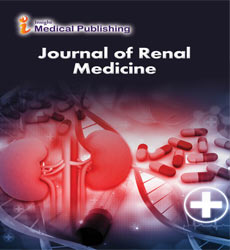Future Horizons: Advances in Renal Medicine and Patient Care
Stephen Piana*
Department of Nephrology, University of Michigan, Ann Arbor, USA
- *Corresponding Author:
- Stephen Piana
Department of Nephrology, University of Michigan, Ann Arbor,
USA,
E-mail: piana.s@foxmail.com
Received date: August 29, 2024, Manuscript No. IPJRM-24-19824; Editor assigned date: September 02, 2024, PreQC No. IPJRM-24-19824 (PQ); Reviewed date: September 16, 2024, QC No. IPJRM-24-19824; Revised date: September 23, 2024, Manuscript No. IPJRM-24-19824 (R); Published date: September 30, 2024, DOI: 10.36648/ipjrm.7.5.50
Citation: Piana S (2024) Future Horizons: Advances in Renal Medicine and Patient Care. J Ren Med Vol.7 No.5: 50.
Description
Renal medicine, the branch of medicine focused on the kidneys, is undergoing a transformative period characterized by innovative research and develop that to change the landscape of diagnosis, treatment and management of kidney diseases. With Chronic Kidney Disease (CKD) affecting millions worldwide, advancements in this field are critical for improving patient outcomes and quality of life. The future of renal medicine is not solely about technological advancements it also includes a shift towards patient-centric care. Mobile applications and wearable devices enable patients to monitor their health, track symptoms and communicate with healthcare providers in real-time.
Innovations in early detection
One of the most areas of research in renal medicine is early detection and prevention of CKD. Traditional methods of diagnosing kidney disease, such as serum creatinine tests and urine analysis, may not detect kidney dysfunction until it is significantly advanced. Recent studies have focused on biomarkers that can signal kidney injury earlier in the disease process. For instance, the discovery of urinary biomarkers like Neutrophil Gelatinase-Associated Lipocalin (NGAL) and Kidney Injury Molecule-1(KIM-1) has shown potential for early detection. These biomarkers could revolutionize screening processes, allowing for timely interventions that may halt or slow disease progression. Genetic research is another frontier in renal medicine. Understanding the genetic basis of kidney diseases can lead to personalized treatment options. For instance, researchers are study the role of genetic mutations in conditions such as alport syndrome and polycystic kidney disease. Genome sequencing technologies have made it possible to identify these mutations more easily, enabling targeted therapies. In particular, gene editing technologies like Clustered Regularly Interspaced Short Palindromic Repeats (CRISPR) are being investigated for their potential to correct genetic defects associated with certain renal diseases. While still in the experimental stages, such advancements could lead to innovative therapies that address the root causes of kidney diseases rather than just managing symptoms.
Novel therapies and drug development
The pharmaceutical landscape for renal medicine is also evolving. Traditional treatment options for CKD often focus on managing symptoms and complications rather than slowing disease progression. However, recent clinical trials are study new drugs that target the underlying mechanisms of kidney disease. Sodium Glucose Cotransporter-2 (SGLT2) inhibitors, which were first created to control diabetes, have been found to lower the risk of Chronic Kidney Disease (CKD) development. These medications work by preventing glucose reabsorption in the kidneys, leading to improved kidney function and reduced cardiovascular risk. To completely comprehend their long-term impacts and processes, research is still underway. Another exciting area is the development of therapies that can regenerate kidney tissue. Stem cell research is at the forefront of this effort, with studies study the potential of pluripotent stem cells to differentiate into kidney cells. If effective, this might result in innovative therapies that help patients with severe illness regain their kidney function. On the other hand, conventional hemodialysis may be difficult and painful. The goal of dialysis technology innovations is to improve patient outcomes and experiences. In order to allow patients greater mobility and flexibility, wearable prosthetic kidneys and portable dialysis devices are being developed. These devices could allow for home-based treatments that are less disruptive to daily life. Furthermore, improvements in artificial membranes and biocompatible materials might improve the comfort and effectiveness of dialysis treatments. For many End-Stage Renal Disease (ESRD) patients, kidney transplantation is the best course of therapy however, there is a severe shortage of donor kidneys. Research is study alternative sources for transplantation, including Xenotransplantation are using genetically modified pig kidneys for human transplantation is being investigated as a potential solution to the organ shortage crisis. Early studies have shown, but ethical and safety concerns must be addressed. Using a patient's own cells, 3D bioprinting is an emerging technique that has the potential to generate the operate kidney tissues. While still in the experimental stage, 3D-printed organs could one day eliminate the need for donor organs altogether. Telemedicine has become increasingly important, especially following the COVID-19 pandemic. Remote consultations lower access barriers and improve overall treatment by enabling prompt interventions and support for patients with renal problems. Renal medicine has much optimism for the future. As researchers continue to study new approach in early detection, genetic research, novel therapies and technological innovations, the landscape of kidney disease management is set to evolve dramatically These developments will not only improve patient outcomes but also raise the standard of living for the millions of people who suffer from renal illnesses. With ongoing commitment from researchers, clinicians and patients alike, the vision for a future where kidney diseases are effectively prevented, diagnosed and treated is becoming increasingly attainable. As we stand on the brink of these exciting developments, it is essential to continue encourage collaboration across disciplines to ensure that these develop translate into tangible benefits for patients.
Open Access Journals
- Aquaculture & Veterinary Science
- Chemistry & Chemical Sciences
- Clinical Sciences
- Engineering
- General Science
- Genetics & Molecular Biology
- Health Care & Nursing
- Immunology & Microbiology
- Materials Science
- Mathematics & Physics
- Medical Sciences
- Neurology & Psychiatry
- Oncology & Cancer Science
- Pharmaceutical Sciences
